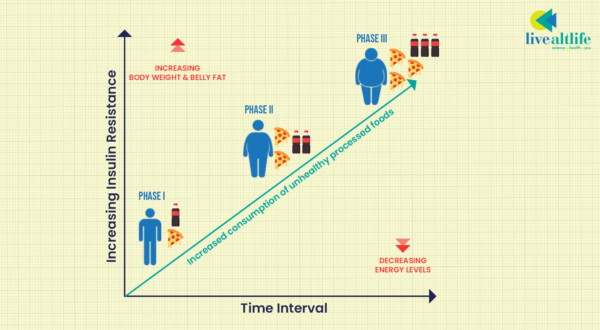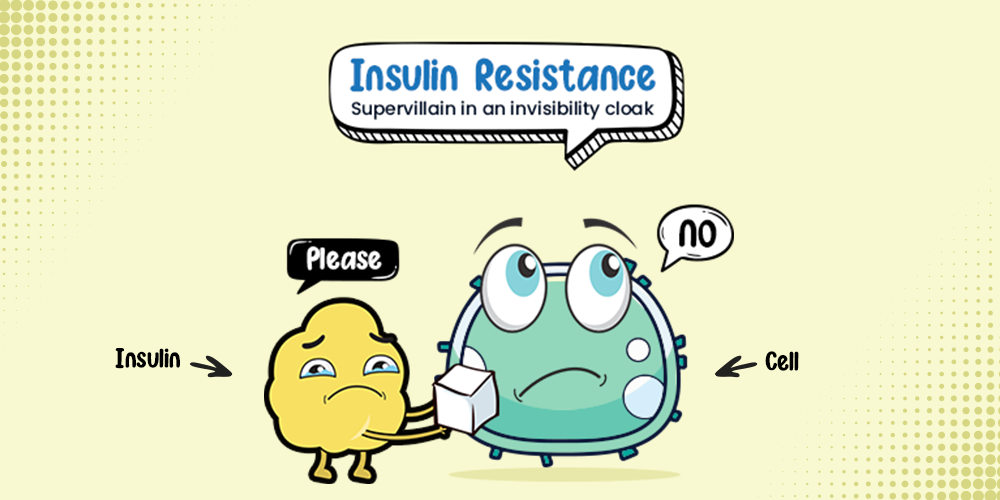From living as hunters & gatherers to working from home, our lifestyles have completely changed over the last millennium. Our food habits have also significantly evolved, and technology has paved the way for a comfortable and sedentary life. However, this adaptation to the so-called ‘modern lifestyle’ puts us at risk of developing a condition called Insulin Resistance – considered as one of the root causes of lifestyle conditions like Type 2 Diabetes, Hypertension, PCOS and Heart Diseases.
Insulin Resistance
Like a car needs fuel to run, our body needs food to generate energy. A major part of our food comprises carbs, proteins and fats. As it travels down our food pipe, into the stomach and to the intestines, it is acted upon by various enzymes and digestive juices that breaks it into smaller and easy to digest pieces. The carbs are broken down into smaller units called ‘glucose’.

Our cells use glucose to generate energy, but for that to happen, first, the circulating glucose must enter the cells through a locked door. The pancreas, as a response, releases’ insulin’, a master hormone, that acts as a key to unlock the door and help glucose enter and produce energy. Our modern diet includes bread, buns, pizzas, pasta, wheat products, rice, and rice products, and processed foods, and is rich in carbohydrates. With unchecked consumption of these foods, a considerable amount of glucose is generated during digestion. The pancreas, as a result, produces more insulin to be able to push the excess glucose into the cells effectively.

Over the years, with repeated overexposure to insulin, the cells become resistant to insulin’s call to accommodate more glucose. As a result, insulin efficiency reduces, and as compensation, the pancreas continues to release more and more insulin. This vicious cycle results in high levels of insulin, high levels of blood glucose and ultimately worn-out pancreas, a condition known as ‘Insulin Resistance’.

According to NCEP ATP III (revised 2005), a confirmation of three or more of the following indicators implies that the person has developed “Insulin Resistance” in the body
- High blood glucose level (>100mg/dl)
- Waist circumference (>40 inches for men and >35 inches for women)
- High Triglycerides (>150 mg/dl)
- Low HDL’ good’ cholesterol (<40 mg/dl)
- Constant high blood pressure (beyond 130/85)
Insulin Resistance increases the risk for prediabetes, type 2 diabetes, and a host of other serious health problems.
Causes of Insulin Resistance
Not one but a combination of factors, along with an unhealthy diet, contributes to Insulin Resistance. Obesity, ageing, genetics, sedentary lifestyle, smoking, the burden of everyday stress, and even missing out on sleep are a few to mention.
Phases of Insulin Resistance
Insulin Resistance cannot happen overnight. It takes a while and even a couple of decades to show its impacts. Let’s have a look at the incubation process of Insulin Resistance to understand how it sets in.

Phase 1 (The beginning)
Insulin Resistance doesn’t set in immediately.
It is the gradual result of repeated abuse to the body by unhealthy lifestyle practices like diets rich in processed carbs, lack of physical activity, ever-increasing stress both personal and professional and, more importantly, losing quality sleep. All these choices put us at risk of Insulin Resistance. We don’t realize unless a few noticeable symptoms like general lethargy and weight gain are observed. Since these signs are subtle, we generally disregard the symptoms attributing it to ageing or something of no importance or concern.
Phase 2 (The warning)
As we continue to abuse the body, the following changes are observed, which indicate that our body is giving warning signs of falling into the trap of Insulin Resistance –
- Accumulation of visceral fat (deposition of fat around the internal organs) inhibits the organs from efficiently carrying out their functions
- A slight bulge in the belly- often gets ignored
- Frequent fatigue – getting tired even when completing simple tasks
Phase 3 (The Manifestation)
The takeover is complete!
- Insulin also induces fat deposition in the body. When Insulin Resistance sets in, the excess insulin leads to increased fat deposition around internal organs, especially around the belly.
- Excess glucose in blood starts to hamper the functions of haemoglobin, leading to damaged inner walls of the arteries. This causes inflammation and may even lead to heart-related disorders if left unattended.
- As the damage goes beyond the body’s ability to manage symptoms such as malaise, fatigue, increasing waist size, decreased memory function, and unexplained weight gain get manifested.
However, there is hope! Be cognizant of your actions and make the right choice to improve and maintain your health.
Key Takeaway
With the right lifestyle interventions like a diet balanced in macro and micronutrients, improved physical activity, sleep management and circadian rhythm alignment, it is never too late to reverse health conditions caused by Insulin Resistance.







Leave A Comment